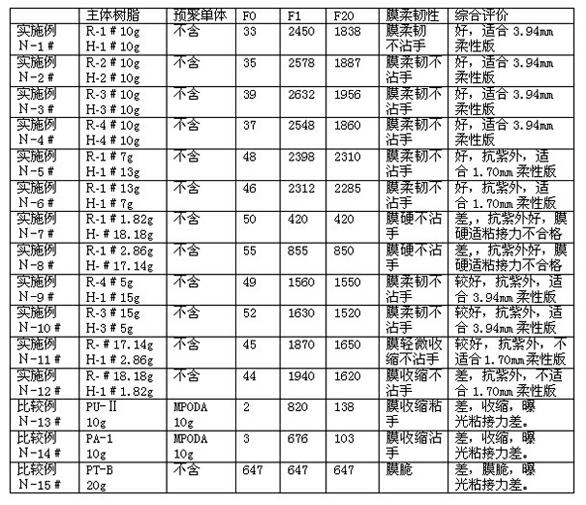Ultraviolet curing adhesive
A technology of ultraviolet light and adhesives, applied in the direction of adhesives, adhesive types, polyurea/polyurethane adhesives, etc., can solve the problems of industrial implementation difficulties, decreased adhesion, complicated operation, etc., and achieve good UV resistance Destructive ability, reduction of internal stress damage, good film flexibility
- Summary
- Abstract
- Description
- Claims
- Application Information
AI Technical Summary
Problems solved by technology
Method used
Image
Examples
Synthetic example 1
[0093] Synthesis example 1 (synthesis of R resin: R-1﹟)
[0094] Add 90 ml of DMF (N,N-dimethylformamide) and 70.83 g (0.27 mol) of HMDI (dicyclohexylmethane) to a 500 ml four-necked flask with a reflux device and a drying tube. Diisocyanate), 11.77g (0.07mol) HDI (hexamethylene diisocyanate), stir well and add TEG (triethylene glycol) 12.01g (0.08mol), DMPA (2,2-bismethylol propionic acid) 34.87g (0.26mol), after the dissolution is complete, add 0.5g of dibutyltin dilaurate, raise the temperature to 60°C, keep warm for 2 hours, add DMF110ml, continue the reaction, add dibutyltin dilaurate after 5.5 hours 0.1 g, and 3.20 g (0.10 mol) of methanol as an end-blocking agent. Half an hour later, the reaction of the synthetic matrix resin RM was completed.
[0095] Add 160 ml of DMF, 5.60 g of BTMA (benzyltrimethylammonium chloride), 2.1 g of TPP (triphenylphosphine), and 1.4 g of ZJ-701 (nitroxyl piperidinol) to the above-mentioned matrix resin RM reaction solution. g, CMA (3,4-e...
Synthetic example 2
[0097] Synthesis example 2 (synthesis of R resin: R-2﹟)
[0098] Add 90 ml of DMF (N,N-dimethylformamide) and 70.83 g (0.27 mol) of HMDI (dicyclohexylmethane) to a 500 ml four-necked flask with a reflux device and a drying tube. Diisocyanate), 11.77g (0.07mol) HDI (hexamethylene diisocyanate), stir well and add TEG (triethylene glycol) 12.01g (0.08mol), DMPA (2,2-bismethylol propionic acid) 34.87g (0.26mol), after the dissolution is complete, add 0.5g of dibutyltin dilaurate, raise the temperature to 60°C, keep warm for 2 hours, add DMF110ml, continue the reaction, add dibutyltin dilaurate after 5.5 hours 0.1 g, and 3.20 g (0.10 mol) of methanol as an end-blocking agent. Half an hour later, the reaction of the synthetic matrix resin RM was completed.
[0099] Add 160 ml of DMF, 5.60 g of BTMA (benzyltrimethylammonium chloride), 2.1 g of TPP (triphenylphosphine), and 1.4 g of ZJ-701 (nitroxyl piperidinol) to the above-mentioned matrix resin RM reaction solution. g. GMA (glyci...
Synthetic example 3
[0101] Synthesis example 3 (synthesis of R resin: R-3﹟)
[0102] Add 81.33g (0.31mol) of HMDI (dicyclohexylmethane diisocyanate) and 6.73g (0.04mol) of HDI (hexamethylene diisocyanate) to a 500 ml four-necked flask with a reflux device and a drying tube. Add 10g (0.01mol) of PPG-1000 (polyoxypropylene glycol, molecular weight 1000±70, hydroxyl value 105-117)) which has been removed under reduced pressure and stir evenly, then add 0.5g of dibutyltin dilaurate and heat up to After 1.5 hours of bulk reaction at 80°C, cool down to 60°C, add 90 ml of DMF (N,N-dimethylformamide), DMPA (2,2-bismethylolpropane) dried over anhydrous sodium sulfate Acid) 45.60g (0.34mol), add DMF110ml after reaction for one hour, add 0.1g of dibutyltin dilaurate and end-blocker methanol 3.20g (0.10mol) after continuing reaction for 4 hours, synthesize matrix resin after half an hour The RM reaction is complete.
[0103] Add DMF160 ml, BTMA (benzyltrimethylammonium chloride) 7.11g, TPP (triphenylphosph...
PUM
| Property | Measurement | Unit |
|---|---|---|
| acid value | aaaaa | aaaaa |
| thickness | aaaaa | aaaaa |
| acid value | aaaaa | aaaaa |
Abstract
Description
Claims
Application Information
 Login to View More
Login to View More - R&D
- Intellectual Property
- Life Sciences
- Materials
- Tech Scout
- Unparalleled Data Quality
- Higher Quality Content
- 60% Fewer Hallucinations
Browse by: Latest US Patents, China's latest patents, Technical Efficacy Thesaurus, Application Domain, Technology Topic, Popular Technical Reports.
© 2025 PatSnap. All rights reserved.Legal|Privacy policy|Modern Slavery Act Transparency Statement|Sitemap|About US| Contact US: help@patsnap.com

